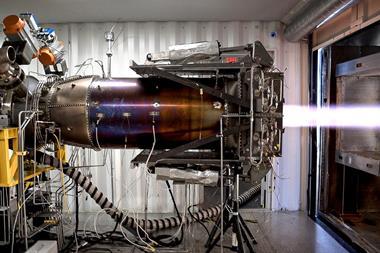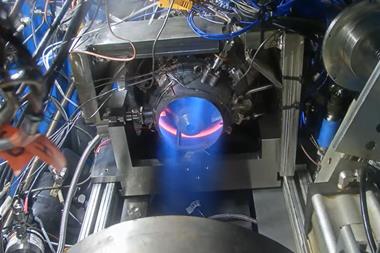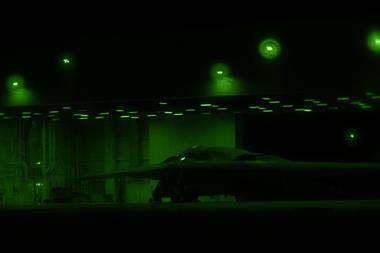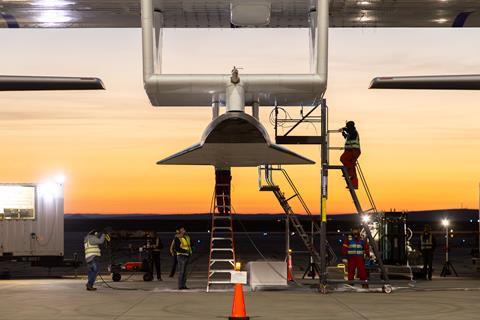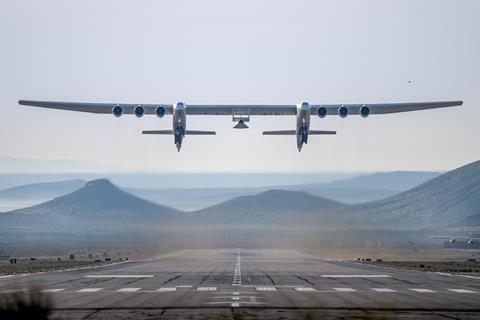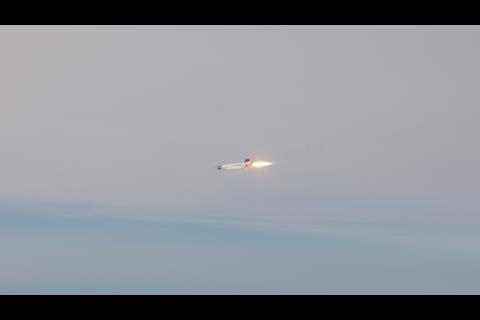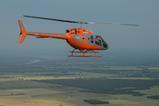In a scene that could have been taken from science fiction, a start-up firm in the USA has achieved a major milestone in the race for reusable hypersonic flight.
California-based Stratolaunch successfully completed the much-anticipated first powered flight of the company’s Talon-A hypersonic test vehicle on 9 March.
The uncrewed aircraft, which resembles a miniature Rockwell Space Shuttle, was dropped from a six-engined, twin-fuselage captive-carry aircraft known as Roc high above the California desert.
Video from the event shows the black-and-white Talon-A falling away from the mother ship, holding a stable horizontal profile in free fall for approximately 10s before the craft’s single rocket engine ignites with a flash.
The first Talon-A flight also included vehicle acceleration, sustained climb at altitude and, finally, a controlled water landing, according to Stratolaunch.
While the flight did not achieve full hypersonic speed, which is generally defined as Mach 5 and faster, Stratolaunch chief executive Zachary Krevor framed the test as a success.
“In addition to meeting all primary customer objectives of the flight, we reached high supersonic speeds approaching Mach 5 and collected a great amount of data,” Krevor says.
The company declines to reveal specific details about the flight profile, such as the exact speed and altitude reached, citing proprietary agreements with customers.
Stratolaunch is primarily funded by private investors but has also secured military research grants, including contracts with the US Air Force Research Laboratory.
The Talon-A programme represents the USA’s first privately-funded effort to develop a hypersonic test aircraft. Stratolaunch’s goal with Talon-A is to produce a reusable flight-test platform that will reduce both the cost and time associated with hypersonic development.
“Stratolaunch’s repeatable approach enables rapid, iterative testing – increasing the pace of access to the hypersonic environment, while reducing development cost, schedule and risk,” the company says.
Talon-A will have ability to fly a variety of hypersonic flight profiles, according to Stratolaunch, while carrying customised payload experiments. The type is powered by a Hadley rocket engine, developed by Colorado-based manufacturer Ursa Major.
While the first Talon-A flight vehicle – designated TA-1 – was a single-use design, subsequent airframes under fabrication will be capable of repeated flight. Two follow-on Talon-As, which are designated TA-2 and TA-3, are now being assembled.
The US Air Force last October committed an undisclosed amount of funding to support the fabrication of TA-3 and at least one test flight.
Krevor says data gathered during the expendable TA-1 flight will help support the launch of the first reusable Talon-A.
“Our goal with this flight was to continue our risk reduction approach for TA-2’s first reusable flight,” he notes. “We are excited to review the data from today’s test and use it as we plan our next steps toward TA-2’s first flight later this year.”
In addition to producing additional Talon-As, Stratolaunch is developing a second captive-carry aircraft named the Spirit of Mojave, based on a modified Boeing 747-400 passenger jet.
The company’s Roc mother ship is believed to be the largest aircraft currently flying anywhere in the world.
The all-composite, over-wing aircraft (registration N351SL) was created by Scaled Composites as a purpose-built air-launch vehicle for Stratolaunch.
Roc boasts a 117m (385ft) wingspan and is powered by six engines originally developed for the 747. Stratolaunch says Roc boasts payload capacity of 226,800kg (500,000lb).
Stratolaunch competitor Hermeus is also progressing a hypersonic aircraft design. The Atlanta-based company in January completed ground testing on a non-flying test version of its Quarterhorse design, which Hermeus ultimately hopes will break the current flight speed record set by the Lockheed Martin SR-71 Blackbird.






















